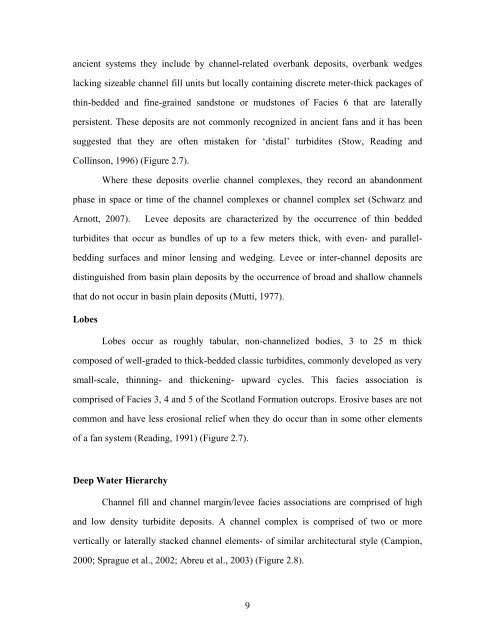Copyright by Nysha Chaderton 2009 - The University of Texas at ...
Copyright by Nysha Chaderton 2009 - The University of Texas at ...
Copyright by Nysha Chaderton 2009 - The University of Texas at ...
You also want an ePaper? Increase the reach of your titles
YUMPU automatically turns print PDFs into web optimized ePapers that Google loves.
ancient systems they include <strong>by</strong> channel-rel<strong>at</strong>ed overbank deposits, overbank wedges<br />
lacking sizeable channel fill units but locally containing discrete meter-thick packages <strong>of</strong><br />
thin-bedded and fine-grained sandstone or mudstones <strong>of</strong> Facies 6 th<strong>at</strong> are l<strong>at</strong>erally<br />
persistent. <strong>The</strong>se deposits are not commonly recognized in ancient fans and it has been<br />
suggested th<strong>at</strong> they are <strong>of</strong>ten mistaken for ‘distal’ turbidites (Stow, Reading and<br />
Collinson, 1996) (Figure 2.7).<br />
Where these deposits overlie channel complexes, they record an abandonment<br />
phase in space or time <strong>of</strong> the channel complexes or channel complex set (Schwarz and<br />
Arnott, 2007). Levee deposits are characterized <strong>by</strong> the occurrence <strong>of</strong> thin bedded<br />
turbidites th<strong>at</strong> occur as bundles <strong>of</strong> up to a few meters thick, with even- and parallel-<br />
bedding surfaces and minor lensing and wedging. Levee or inter-channel deposits are<br />
distinguished from basin plain deposits <strong>by</strong> the occurrence <strong>of</strong> broad and shallow channels<br />
th<strong>at</strong> do not occur in basin plain deposits (Mutti, 1977).<br />
Lobes<br />
Lobes occur as roughly tabular, non-channelized bodies, 3 to 25 m thick<br />
composed <strong>of</strong> well-graded to thick-bedded classic turbidites, commonly developed as very<br />
small-scale, thinning- and thickening- upward cycles. This facies associ<strong>at</strong>ion is<br />
comprised <strong>of</strong> Facies 3, 4 and 5 <strong>of</strong> the Scotland Form<strong>at</strong>ion outcrops. Erosive bases are not<br />
common and have less erosional relief when they do occur than in some other elements<br />
<strong>of</strong> a fan system (Reading, 1991) (Figure 2.7).<br />
Deep W<strong>at</strong>er Hierarchy<br />
Channel fill and channel margin/levee facies associ<strong>at</strong>ions are comprised <strong>of</strong> high<br />
and low density turbidite deposits. A channel complex is comprised <strong>of</strong> two or more<br />
vertically or l<strong>at</strong>erally stacked channel elements- <strong>of</strong> similar architectural style (Campion,<br />
2000; Sprague et al., 2002; Abreu et al., 2003) (Figure 2.8).<br />
9
















